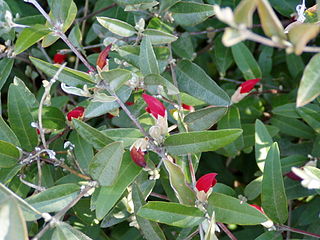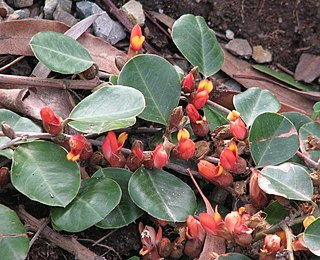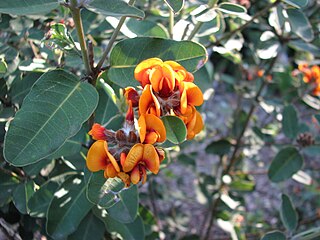
Porongurup National Park is a national park in the Great Southern region of Western Australia. It covers 26.21 square kilometres (10.12 sq mi), and is 360 kilometres (220 mi) southeast of Perth and 40 kilometres (25 mi) north of Albany.

Sodium fluoroacetate, also known as compound 1080, is an organofluorine chemical compound with the formula FCH2CO2Na. This colourless salt has a taste similar to that of sodium chloride and is used as a rodenticide.

Gastrolobium is a genus of flowering plants in the family Fabaceae. There are over 100 species in this genus, and all but two are native to the south west region of Western Australia.

Gastrolobium melanopetalum is a shrub in the family Fabaceae which is endemic to the south-west of Western Australia.

Gastrolobium praemorsum is a scrambling shrub which is endemic to the south-west of Western Australia. It is a member of the family Fabaceae and produces red pea-flowers from late winter to early summer. It is not known whether this species shares the toxic properties of many other members of the genus Gastrolobium.

Gastrolobium celsianum, the Swan River pea, is a low-growing shrub which is endemic to Western Australia.

Gastrolobium sericeum is a flowering plant in the family Fabaceae. It is endemic to the south-west of Western Australia. It is a prostrate, low shrub with pendulous yellow, green, red or nearly black pea-flowers from spring to summer.

Gastrolobium grandiflorum, commonly known as wallflower poison, wallflower poison bush or heart-leaf poison bush, is a bushy shrub which is endemic to Australia.

Gastrolobium spinosum, also known as prickly poison, is a shrub in the family Fabaceae. It is endemic to Southwest Australia
Gastrolobium propinquum is a shrub in the family Fabaceae, endemic to the Southwest Australia savanna region, which is toxic to many animals. It has been given the common name Hutt River poison.

Gastrolobium lehmannii, the Cranbrook pea, is a vulnerable shrub in the family Fabaceae which is endemic to an area of Western Australia.

Gastrolobium minus, also known as broad-leaved brachysema, is a prostrate shrub which is endemic to the south-west of Western Australia. It is a member of the family Fabaceae and of the genus Gastrolobium, which contains many toxic species, however the toxicity of this species is unknown.

Gastrolobium coriaceum is a shrub species in the family Fabaceae. It is endemic to the south west of Western Australia.

Gastrolobium leakeanum, commonly known as the mountain pea, is a plant in the pea family Fabaceae that is endemic to a small area in the south-west of Western Australia. It is an erect or sprawling shrub to about 2 m high, with red to orange or yellow flowers in spring.

Gastrolobium formosum is a small, trailing shrub, with red flowers, in the pea family (Fabaceae), which grows up to a metre high, on clays and loam in swamps and along river banks. The inflorescence consists of head of four unstalked flowers which is sheathed by a whorl of large bracts, with the flower petals being obscured by the lower calyx lobes. The standard petal is less than on third the keel petal. It is native to the south-west of Western Australia.

Gastrolobium nervosum is a small shrub in the pea family (Fabaceae), native to Western Australia.

Gastrolobium rigidum is a small bushy shrub in the pea family (Fabaceae), native to Western Australia.

Gastrolobium villosum is a low spreading shrub in the pea family (Fabaceae), native to Western Australia. Like most Gastrolobiums it is poisonous to stock.
Gompholobium gompholobioides is a species of flowering plant in the family Fabaceae and is endemic to the south-west of Western Australia. It is a spreading shrub with pinnate leaves and uniformly yellow, pea-like flowers.

Mirbelia seorsifolia is a species of flowering plant in the family Fabaceae and is endemic to the south-west of Western Australia. It is an erect, open shrub that typically grows to a height of 15–70 cm (5.9–27.6 in) and has yellow and red flowers from August to December. It grows on sandplains in the Avon Wheatbelt, Coolgardie, Great Victoria Desert, Murchison and Yalgoo bioregions of south-western Western Australia. The species was first formally described in 1876 by Ferdinand von Mueller, who gave it the name Gastrolobium seorsifolium in Fragmenta Phytographiae Australiae. In 1943, Charles Gardner changed the name to Mirbelia seorsifolia in Enumeratio Plantarum Australiae Occidentalis. The specific epithet (seorsifolia) means "separate leaves", referring to the well-spaced leaves. Mirbelia seorsifolia is listed as "not threatened" by the Government of Western Australia Department of Biodiversity, Conservation and Attractions.


















